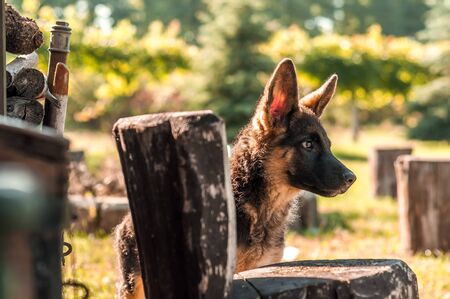Introduction to Indian Dog Breeds for Security
When it comes to home security in India, many families prefer Indian dog breeds over foreign ones. This choice is not just about loyalty or cost-effectiveness, but also because these native breeds have naturally adapted to the diverse Indian climate and living conditions. Whether it is the scorching heat of Rajasthan, the humid coasts of Kerala, or the chill of the Himalayas, Indian dog breeds like the Rajapalayam, Kombai, Mudhol Hound, and Gaddi Kutta have proven their resilience and reliability. Over generations, these dogs have evolved alongside local communities, making them not only effective guard dogs but also culturally significant companions. Their strong territorial instincts, alertness, and ability to thrive on simple diets further make them ideal protectors for Indian homes. Moreover, their presence is deeply rooted in Indian culture—many regional stories and traditions celebrate these loyal canines as guardians and symbols of pride. For households seeking both security and a sense of cultural connection, choosing an Indian breed offers unmatched benefits.
Top Indian Dog Breeds for Home Security
India is home to several indigenous dog breeds that are highly effective as guard dogs, thanks to their natural instincts, adaptability to local climates, and centuries-old roles as protectors. Here, we provide a detailed introduction to the most recommended Indian breeds for home security: Rajapalayam, Kombai, Mudhol Hound, and Gaddi Kutta. Each of these breeds possesses unique characteristics that make them well-suited for guarding Indian homes.
Highly Recommended Indian Guard Dog Breeds
| Breed | Origin | Main Characteristics | Suitability for Home Security |
|---|---|---|---|
| Rajapalayam | Tamil Nadu (South India) | Large, muscular build; short white coat; loyal and alert temperament; strong territorial instinct. | Excellent for guarding independent houses and farmhouses. Highly protective towards family members but wary of strangers. |
| Kombai | Tamil Nadu (South India) | Medium-sized; reddish-brown coat; fearless and courageous; known for agility and loyalty. | Ideal for rural homes and properties with open spaces. They are fierce protectors and bond closely with their owners. |
| Mudhol Hound | Karnataka & Maharashtra (Deccan Plateau) | Sleek, athletic body; short coat in various colours; intelligent and energetic; keen sense of sight and smell. | Suitable for both urban and rural settings. Excellent watchdogs due to their alertness, but require regular exercise. |
| Gaddi Kutta | Himalayan region (North India) | Large, thick double coat; robust physique; strong-willed and brave; high endurance in harsh climates. | Best for homes in colder regions or with large compounds. Renowned for protecting livestock as well as property. |
Why Choose Indian Breeds for Home Security?
Indian dog breeds have evolved over generations to withstand local weather conditions, diseases, and terrains. Unlike many foreign breeds, they require minimal maintenance and adapt quickly to traditional Indian households. Their loyalty, intelligence, and inherent protective instincts make them not only reliable guards but also affectionate family members. For families looking for trustworthy canine companions who can offer security without compromising on bonding, these Indian breeds are truly the best choice.

3. Understanding the Temperament and Needs of Indian Breeds
Indian guard dog breeds such as the Rajapalayam, Mudhol Hound, Kombai, and Gaddi Kutta have evolved over centuries to suit the unique climate, geography, and lifestyle of Indian households. These breeds are known for their loyalty, alertness, and strong protective instincts—traits that make them excellent home security companions. However, each breed brings its own temperament and energy levels to the family setting.
Typical Temperament of Indian Guard Dogs
Most native Indian breeds are naturally wary of strangers but deeply bonded with their families. For example, the Rajapalayam is famously reserved around outsiders yet gentle with children in the home. Mudhol Hounds are energetic and vigilant, always ready to respond to unfamiliar sounds or movements. It’s important to respect their innate guarding instincts while ensuring they do not become overly aggressive or territorial—early socialisation is key.
Energy Levels and Daily Exercise Needs
Indian breeds generally possess high stamina due to their historical roles as working and hunting dogs. They require regular physical activity—morning and evening walks, games of fetch in a courtyard, or agility exercises—to stay healthy and prevent boredom-induced behavioural issues. Without adequate exercise, these dogs might resort to destructive chewing or excessive barking.
Integrating Indian Breeds into Family Life
To successfully integrate an Indian guard dog into your home, involve all family members in basic training routines and daily care. Children should be taught how to interact respectfully with the dog. Providing a designated space within the house or compound for your dog to relax helps them feel secure. Additionally, Indian dogs adapt well to the local climate but still need shelter from harsh sun or rain—consider a shaded kennel or a cozy corner indoors.
By understanding the unique temperament and requirements of Indian breeds, you can create a harmonious environment where your dog thrives as both a loyal companion and an effective protector for your home.
4. Effective Training Methods for Indian Guard Dogs
When it comes to training Indian guard dogs for home security, a culturally relevant and practical approach works best. Indian households are often bustling with family members, guests, and domestic help, so your dog must be not only alert but also well-socialised and obedient. Here’s how you can train popular Indian breeds like the Rajapalayam, Kombai, Mudhol Hound, or Gaddi Kutta to become loyal protectors of your home.
Daily Training Routine Tailored for Indian Homes
| Time | Activity | Purpose |
|---|---|---|
| Morning (6-8 AM) | Leash walk around colony/park | Socialisation & obedience commands amidst regular hustle |
| Noon (12-1 PM) | Short play session inside home/garden | Bonding & releasing excess energy |
| Evening (5-7 PM) | Guard dog drills at main gate/compound wall | Scent work & boundary familiarisation |
| Night (9-10 PM) | Calm settle-down routine in designated sleeping spot | Ensures dog is relaxed & knows their place in the household hierarchy |
Culturally Sensitive Socialisation Tips
- Acclimatise to Guests: In India, unexpected guests are common. Teach your dog to differentiate between family friends and strangers by introducing them regularly to visitors under supervision.
- Desensitise to Street Sounds: Expose your pup gradually to typical Indian street noises—vendors, cycles, honking—to avoid nervousness or over-reactivity.
- Puja and Festive Gatherings: Make your dog comfortable during loud festivals or religious gatherings at home by rewarding calm behaviour with treats and affection.
Obedience Basics Using Local Commands
Using commands in local languages (like Hindi, Tamil, Kannada) can make your dog respond better, as these are more familiar to both the handler and household staff. For example:
| Command (English) | Hindi Example | Tamil Example |
|---|---|---|
| Sit | Baito (बैठो) | Utkaaru (உட்கார்) |
| Stay | Ruko (रुको) | Nillu (நில்) |
| No/Bark Stop | Nahi (नहीं) | Illa (இல்லை) |
Mental Stimulation and Security Drills
- Create scent trails using old clothes or house keys to practice tracking skills around the compound.
- Set up mock intruder scenarios with trusted family members so your dog learns when to bark and when to stay calm.
Positive Reinforcement Works Best
Avoid harsh punishments. Reward good behaviour with homemade treats like paneer cubes or boiled chicken. Consistency and patience are key for raising an alert yet gentle Indian guard dog who is both a loyal family companion and a reliable protector.
5. Common Challenges and Solutions in Training
Training Indian dog breeds for home security can be quite rewarding, but pet parents often encounter a few bumps on the road. Understanding these challenges and knowing some practical, locally inspired solutions can make the journey smoother.
Stubbornness or Lack of Focus
Some breeds like Rajapalayam or Kombai are known to be independent thinkers. If your furry friend seems uninterested in following commands, it could simply be their natural temperament.
Desi Tip:
Use high-value treats like paneer cubes or small bits of chicken as motivation. Keep training sessions short—about 10-15 minutes—and always end on a positive note. Patience is key, yaar!
Socialisation Issues
Many Indian breeds are naturally wary of strangers, which is great for security but can lead to aggression or fear if not socialised properly.
Desi Tip:
Start introducing your dog to different people, sounds, and environments from a young age. Take your dog along to local parks, busy markets (sabzi mandi), or let them meet neighbours under controlled conditions. Always reward calm behaviour.
Barking Excessively
Guard dogs tend to be vocal, but excessive barking can become a nuisance for both family and neighbours.
Desi Tip:
Teach the “quiet” command using positive reinforcement. If your dog barks at every scooter horn or vendor’s call, calmly redirect their attention with treats or toys. Consistency works wonders!
Lack of Proper Space
Not everyone has a bungalow with a big backyard; many families live in apartments or compact homes.
Desi Tip:
If outdoor space is limited, ensure regular walks and mental stimulation through interactive games like “find the treat” using household items. Even terrace playtime can help burn off energy.
Misunderstanding Breed Needs
Each Indian breed has unique exercise, grooming, and training requirements. A Mudhol Hound needs more exercise than a Bhotia, for example.
Desi Tip:
Talk to local breeders or vets who understand the specific needs of Indian breeds. Join WhatsApp groups or online communities dedicated to native dogs for sharing tips and experiences with fellow desi dog lovers.
In summary,
With patience and an understanding of local culture and resources, any Indian dog breed can become both a loyal companion and an effective home guardian. Remember: every challenge has a jugaad solution when you combine love with smart training!
6. Conclusion and Tips for Choosing the Right Breed
When it comes to picking the best Indian dog breed for home security, there are several important factors to consider. Each family and home is unique, so your choice should align with your specific needs. Here are some final thoughts and practical tips to help you make the right decision.
Consider Regional Climate
India’s climate varies greatly from North to South and East to West. Breeds like the Kumaon Mastiff or Gaddi Kutta thrive in colder Himalayan regions, while Rajapalayam and Kanni are better suited for hot and humid southern areas. Make sure your chosen breed will be comfortable year-round in your local weather conditions.
Think About Your Family Setup
If you have young children or elderly family members at home, opt for breeds known for their stable temperament and loyalty, such as the Labrador Retriever (popular in India) or the gentle Indian Pariah Dog. These dogs usually adapt well to family life and can be protective without being overly aggressive.
Assess Living Space
The size of your living space is another key factor. For apartments or smaller homes, a medium-sized breed like the Indie Dog or a well-trained Dachshund can be a great fit. If you have a large house with an open compound or farmhouse, larger breeds such as the Bulli Kutta or Rampur Hound might be more appropriate, as they need more room to move around and patrol.
Cultural Fit and Community Norms
Some residential societies in Indian cities have restrictions on keeping large guard dogs. Always check your local housing society rules before bringing home a new pup. Also, consider how your neighbours feel about certain breeds – choosing a breed that fits into your community will ensure smoother interactions.
Final Words of Advice
No matter which Indian guard dog you choose, early socialisation and consistent training are essential. Invest time in positive reinforcement methods, regular exercise, and clear boundaries from day one. Remember, a happy and well-trained dog is not only an effective guardian but also a loving member of your family.
Take your time to research, visit breeders or shelters if possible, and talk to other Indian dog owners for real-world experiences. With thoughtful planning, you’ll find the perfect companion who can keep your home safe while becoming an integral part of your daily life.


